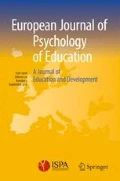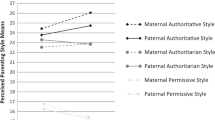Abstract
How do parenting concepts vary within and between the families? The present study regards parenting as a complex family process by considering three concepts of parenting: styles, differential treatment and coparenting consistency. A main question was addressed: whether and how these parenting concepts vary within the families towards siblings or between the two parents, and between the families according to the child's, the parent's and the family's characteristics? The parenting concepts were computed from the EPEP questionnaire (Meunier & Roskam, 2007) in a sample of 101 non-divorced families: 101 mothers and 101 fathers of two siblings from 6- to 12-years-old. The parenting concepts were found to vary within the families towards two siblings and between the mother and the father. They were also found to vary between the families according to the child's age and personality traits as well as a function of the parent's educational level and the number of siblings.
Résumé
Comment les mesures associées à l'activité parentale d'éducation varient-elles au sein des familles et d'une famille à une autre? L'étude considère la parentalité comme un processus familial complexe en l'envisageant à travers trois concepts: le style parental, le traitement parental différencié et la consistance co-parentale. La question traitée dans cette contribution est de quelle manière ces concepts varient au sein des familles selon les enfants de la fratrie ou entre le père et la mère, et entre les familles en fonction des caractéristiques de l'enfant, du parent et de la fratrie. Les mesures de la parentalité sont basées sur le questionnaire Evaluation des Pratiques Educatives Parentales (Meunier & Roskam, 2007) à partir d'un échantillon de 101 familles nucléaires: 101 mères et 101 pères avec deux enfants de la fratrie âgés entre six et douze ans. Les résultats montrent que les mesures de la parentalité varient au sein des familles en fonction des enfants de la fratrie et entre le père et la mère. Ils montrent également que ces mesures varient entre les familles en fonction de l'âge et de la personnalité de l'enfant, du niveau de scolarisation du parent et du nombre d'enfants dans la fratrie.
Similar content being viewed by others
References
Aunola, K., & Nurmi, J.E. (2005). The role of parenting styles in children's problem behaviour.Child Development, 76(6), 1144–1159.
Barrett Singer, A.T., & Weinstein, R.S. (2000). Differential parental treatment predicts achievement and self-perceptions in two cultural contexts.Journal of Family Psychology, 14(3), 491–509.
Baumrind, D. (1971). Current patterns of parental authority.Developmental Psychology, 4, 1–103.
Bell, N.J., & Avery, A.W. (1985). Family structure and parent-adolescent relationships: Does family structure really make a difference?Journal of Marriage and the Family, 47, 503–508.
Blake, J. (1989).Family size and achievement. Berkeley, CA: University of California Press.
Block, J. (1983). Differential premises arising from differential socialization of the sexes: Some conjectures.Child Development, 54, 1335–1354.
Conrade, G., & Ho, R. (2001). Differential parenting styles for fathers and mothers: Differential treatment for sons and daughters.Australian Journal of Psychology, 53(1), 29–35.
Dunn, J., & Plomin, R. (1991). Why are siblings so different? The significance of differences in sibling experiences within the family.Family Process, 30(3), 271–283.
Elder, G.H., & Bowerman, C.E. (1963). Family structure and child-rearing patterns: The effect of family size and sex composition.American Sociological Review, 28, 891–905.
Fagot, B.I. (1995). Parenting boys and girls. In M.H. Bornstein (Ed.),Handbook of parenting (vol. 1, pp. 163–183). Mahwah, NJ: Erlbaum.
Feinberg, M., & Hetherington, E.M. (2001). Differential parenting as a within-family variable.Journal of Family Psychology, 15(1), 22–37.
Furman, W. (1995). Parenting siblings. In M.H. Bornstein (Ed.),Handbook of parenting (vol. 1, pp. 143–162). Mahwah: Lawrence Erlbaum.
Garside, R.B., & Klimes, D.B. (2002). Socialization of discrete negative emotions: Gender differences and links with psychological distress.Sex Roles, 47(3–4), 115–128.
Gerris, J., Dekovic, M., & Janssens, J. (1997). The relationship between social class and childrearing behaviours: Parents' perspective taking and value orientations.Journal of Marriage and the Family, 59, 834–847.
Jenkins-Tucker, C., McHale, S., & Crouter, A.C. (2003). Dimensions of mothers' and fathers' differential treatment of siblings: Links with adolescent's sex-typed personal qualities.Family Relations, 52, 82–89.
Kidwell, J.S. (1981). Number of siblings, sibling spacing, sex and birth order: Their effects on perceived parentadolescent relationships.Journal of Marriage and the Family, 43, 315–332.
Kowal, A., & Kramer, L. (1997). Children's understanding of parental differential treatment.Child Development, 68, 113–126.
Lengua, L.J. (2006). Growth in temperament and parenting as predictors of adjustment during children's transition to adolescence.Developmental Psychology, 42(5), 819–832.
Lengua, L.J., & Kovacs, E.A. (2005). Bidirectional associations between temperament and parenting and the prediction of adjustment problems in middle childhood.Applied Developmental Psychology, 26, 21–38.
Lindahl, K.M. (1998). Family process variables and children's disruptive behaviour problems.Journal of Family Psychology, 12(3), 420–436.
Margolin, G., Gordis, E.B., & John, R.S. (2001). Coparenting: A link between marital conflict and parenting in two-parent families.Journal of Family Psychology, 15(1), 3–21.
McGuire, S., Dunn, J., & Plomin, R. (1995). Maternal differential treatment of siblings and children's behavioral problems: A longitudinal study.Development and Psychopathology, 7, 515–528.
McHale, J.P. (1997). Overt and covert coparenting process in the family.Family Process, 36, 183–201.
McHale, S.M., & Pawletko, T.M. (1992). Differential treatment of siblings in two family contexts.Child Development, 63(1), 68–81.
McHale, S.M., Crouter, A.C., McGuire, S.A., & Uppdegraff, K.A. (1995). Congruence between mothers' and fathers' differential treatment of siblings: Links with family relations and children's well-being.Child Development, 66, 116–128.
McHale, S., Updegraff, K.A., Jackson-Newsom, J., Tucker, C.J., & Crouter, A.C. (2000). When does parents' differential treatment have negative implications for siblings?Social Development, 9(2), 149–172.
Mekos, D., Hetherington, E.M., & Reiss, D. (1996). Sibling differences in problem behaviour and parental treatment in nondivorced and remarried families.Child Development, 67(5), 2148–2165.
Meunier, J.C., & Roskam, I. (2007). Psychometrical properties of a parental childrearing behaviour scale for French-speaking parents, children and adolescents.European Journal of Psychological Assessment, 23(2), 113–124.
Mills, R.S., & Rubin, K. (1992). A longitudinal study of maternal beliefs about children's social behaviours.Merrill Palmer Quarterly, 61, 494–512.
Nicholson, B.C., Fox, R.A., & Johnson, S.D. (2005). Parenting young children with challenging behaviour.Infant and Child Development, 14, 425–428.
Nye, I., Carlson, J., & Garrett, G. (1970). Family size, interaction, affection, and stress.Journal of Marriage and the Family, 32, 216–226.
Patterson, G.R., Reid, J., & Dishion, T. (1992).Antisocial boys. A social interactional approach (vol. 4). Eugene, OR: Castalia Publishing Company.
Pomerantz, E.M., & Ruble, D.N. (1998). The role of maternal control in the development of sex differences in child self-evaluative factors.Child Development, 69(2), 458–478.
Roskam, I., & Schelstraete, M. (2007). Qualitative analysis of mothers' childrearing behaviour towards their disabled child.Research in Developmental Disabilities, 28(2), 130–144.
Roskam, I., Vandenplas-Holper, C., & de Maere-Gaudissart, A. (2000). Mise au point d'un instrument d'évaluation de la personnalité des enfants à partir du Modèle à Cinq Facteurs [Assessment of the child's personality: Validation of bipolar rating scales based on the Five Factor Model].L'Orientation Scolaire et Professionnelle, 29(4), 661–672.
Russell, A., & Russell, G. (1994). Coparenting early school-age children: An examination of mother father interdependence within families.Developmental Psychology, 30(5), 757–770.
Schachter, F.F., Shore, E., Feldman-Rotman, S., Marquis, R.E., & Campbell, S. (1976). Sibling deidentification.Developmental Psychology, 12, 418–427.
Schek, D.C., & Emerick, R. (1976). The young male adolescent's perception of early child-rearing behaviour: The differential effects of socio-economic status and family size.Sociometry, 39, 39–52.
Schoppe, S.J., Mangelsdorf, S.C., & Frosch, C.A. (2001). Coparinting, family process, and family structure: Implications for preschoolers' externalising behaviour problems.Journal of Family Psychology, 15(3), 526–545.
Stocker, C. (1995). Differences in mothers' and fathers' relationships with siblings: Links with children's behaviour problems.Development and Psychopathology, 7, 499–513.
Van Leeuwen, K., & Vermulst, A.A. (2004). Some psychometric properties of the Ghent parental behaviour scale.European Journal of Psychological Assessment, 20(4), 283–298.
Vandenplas-Holper, C., Roskam, I., & Pirot, L. (2006). Mothers' social cognition and self-reported childrearing concerning their child's personality: A content analysis of mothers' free descriptions.European Journal of Developmental Psychology, 3(4), 338–356.
Veenstra, R., Lindenberg, S., Oldehinkel, A.J., de Winter, A.F., & Ormel, J. (2006). Temperament, environment, and antisocial behavior in a population sample of preadolescent boys and girls.International Journal of Behavioral Development, 30, 422–432.
Author information
Authors and Affiliations
Rights and permissions
About this article
Cite this article
Roskam, I., Meunier, J.C. How do parenting concepts vary within and between the families?. Eur J Psychol Educ 24, 33–47 (2009). https://doi.org/10.1007/BF03173473
Received:
Revised:
Issue Date:
DOI: https://doi.org/10.1007/BF03173473




